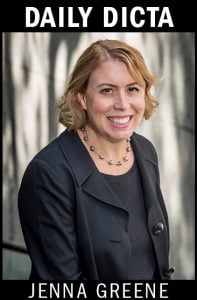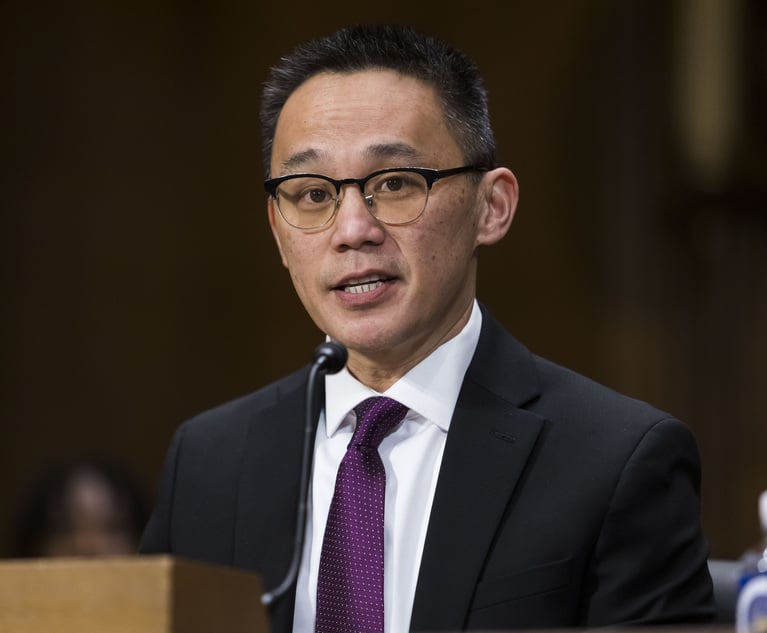For Kennedy Cousin Skakel, a Gold-Plated Standard for Ineffective Assistance of Counsel
As the saying goes, if your lawyer has a pulse, it's not ineffective assistance of counsel. Unless you're Kennedy cousin Michael Skakel, who just had his conviction for murdering Martha Moxley in 1975 overturned.
May 07, 2018 at 11:26 AM
8 minute read

Did you hear about the lawyer who slept through most of his client's cross examination? That was not deemed ineffective assistance of counsel.
Or the lawyer who drank in the morning, during court recess and in the evening each day of trial, and who was arrested while driving to court with a .27 percent blood-alcohol level? Also not ineffective assistance of counsel.
The lawyer who did cocaine and heroin during trial? Or the one who exhibited signs of a paranoid psychotic reaction?
As the saying goes, if the lawyer has a pulse, it's not ineffective assistance of counsel.
 Unless you're a Kennedy cousin.
Unless you're a Kennedy cousin.
The Connecticut Supreme Court on Friday reversed Michael Skakel's conviction for beating 15-year-old Martha Moxley to death with a golf club in 1975, ruling that he's entitled to a new trial.
The reason? His trial counsel, Greenwich, Connecticut-based Mickey Sherman, failed to identify and interview an alibi witness for a portion of the evening when the murder took place.
Considering Skakel paid Sherman more than $2 million for his 2002 trial defense, you'd certainly expect his lawyer to have left no stone unturned.
And there's no question Sherman erred by overlooking the witness. Still, it wasn't just him. So did three associates and defense consultants F. Lee Bailey, William F. Dow III, Richard Emanuel, David S. Golub, David T. Grudberg and Barry Scheck, “some of the most well-known and highly respected attorneys in the state, and even the country,” according to Connecticut Supreme Court Justice Carmen Espinosa.
For that matter, Skakel and his brothers didn't even mention the witness. And it took his new legal team led by Hubert Santos in Hartford eight years post-conviction to flag the omission as well.
And yet, in a 4-3 vote the majority in a motion to rehear the case en banc reversed itself—thanks to the retirement of one judge and the addition of another—and found Sherman's mistake was so glaringly bad that it amounted to ineffective assistance of counsel.
The majority determined that his work fell “below an objective standard of reasonableness,” per the U.S. Supreme Court in Strickland v. Washington. Moreover, there was “a reasonable probability that, but for counsel's unprofessional errors, the result of the proceeding would have been different.”
In a blistering dissent, Espinosa said no way.
“Because the majority's conclusion that he is entitled to a new trial is not based on the evidence or the law, an objective observer might conclude that it must be based on the majority's belief that wealthy, white, politically connected defendants, like the petitioner, are entitled to special treatment from the courts,” she wrote.
Espinosa continued, “Or is it based on the majority's desire to make a splashy statement in a high profile case? Perhaps the majority feels that, even if the petitioner killed Martha, he has been punished enough. After all, the petitioner served eleven years in prison, and, for a prisoner like him, that should be enough time.”
Moxley's murder has fascinated the American public for years, fueled by Dominick Dunne's novel “A Season in Purgatory,” which was made into a mini-series, as well as former LAPD Detective Mark Fuhrman's book, “Murder in Greenwich: Who Killed Martha Moxley?” and countless tabloid stories.
The tale combines wealth and privilege—both the Skakels and Martha Moxley's family lived in the exclusive Belle Haven area of Greenwich, where the average house in 2015 sold for $6.3 million—with a brutal killing that went unsolved for years.
There's the Kennedy patina as well. Michael Skakel's aunt, Ethel Skakel, was married to Bobby Kennedy. If anything, the Skakels (whose fortune came from Great Lakes Carbon) looked down on the Kennedys, who made their money from liquor, according to Dunne.
On the evening of October 30, 1975, the teens of Belle Haven were celebrating “mischief night,” which entailed running around outdoors committing minor acts of vandalism.
Moxley was with the Skakel boys (there were six of them) and other teens when she didn't return home by curfew. She was found the next morning partially unclothed under a pine tree in the back of her parents' house, beaten to death with a golf club that belonged to the Skakel boys' mother, who had died of cancer two years before.
Suspicion initially fell on 17-year-old Tommy, who had made out with Martha that night. Eventually it shifted to Michael, 15, who allegedly had an unrequited crush on her.
Over the years, Michael made incriminating statements to others about the crime, and he changed the story he gave police. He belatedly claimed that he climbed a tree near Martha's house hoping to watch her undress, and that he masturbated (which—bonus—could explain any DNA near the crime scene, had such evidence been found).
But Michael also claimed he and some of his brothers were watching television at his cousin's house for two hours out of the four to eight hour period during which the murder reasonably could have been committed.
The Connecticut Supreme Court majority concluded that the murder most likely took place when Michael was watching TV, pointing to evidence about dogs barking and the fact that Martha missed her curfew. (Never mind that the dogs might have been barking because it was mischief night, and that Martha had missed her curfew before.)
At trial, prosecutors had attacked Michael's partial alibi, suggesting that he and his brothers concocted the story to protect him.
But it turns out, there was an unbiased witness who could have testified Michael Skakel was at the cousin's house—the cousin's “beau,” who remembered seeing him there. But the beau, Denis Ossorio, was not identified or interviewed, probably because the cousin told the grand jury she was in another room and only heard the boys' voices, but didn't see them. Apparently, it didn't occur to anyone to follow up about what the beau might have seen.
That's the unreasonable error that scuttled the conviction.
No doubt it would have been helpful for the defense to have had Ossorio's testimony. But was it actually unreasonable that Sherman didn't track him down?
And if he had, would it have made a difference? Was it substantially likely the jury would have reached a different conclusion if they had heard from Ossorio?
“A simple gut feeling that things might well have gone differently for the petitioner if Ossorio had testified is not enough, as a matter of law,” wrote Justice Dennis G. Eveleigh, who also dissented. “[C]ases almost universally hold that defense counsel's failure to investigate, identify, or present an alibi witness either does not constitute deficient performance or is not prejudicial when that alibi would cover only a portion—even a substantial portion—of the time period during which the crime could have been, or was alleged to have been, committed.”
He continued, “The only evidence that the victim was killed during the alibi period, in fact, are inferences from the barking of dogs, ambiguous testimony regarding the victim's curfew, and pure speculation regarding how an independent, precocious teen-aged girl might or might not have spent her evening. There is literally nothing more. By whatever standards we define a partial alibi, this was one.”
In some ways, what Connecticut has done is admirable. The state high court is apparently insisting defense counsel must diligently follow every lead, and that failure to do so is grounds for ineffective assistance of counsel.
I can't wait to see how they're going to apply such a rigorous standard when the lawyer is a public defender and the defendant is a not a rich, white member of the Kennedy clan.
This content has been archived. It is available through our partners, LexisNexis® and Bloomberg Law.
To view this content, please continue to their sites.
Not a Lexis Subscriber?
Subscribe Now
Not a Bloomberg Law Subscriber?
Subscribe Now
NOT FOR REPRINT
© 2025 ALM Global, LLC, All Rights Reserved. Request academic re-use from www.copyright.com. All other uses, submit a request to [email protected]. For more information visit Asset & Logo Licensing.
You Might Like
View All
Should It Be Left to the Plaintiffs Bar to Enforce Judicial Privacy Laws?
7 minute read
A Reporter and a Mayor: Behind the Scenes During the Eric Adams Indictment News Cycle

Of Predictive Analytics and Robots: A First-Year Federal Judge's Thoughts on AI
Trending Stories
- 1No Two Wildfires Alike: Lawyers Take Different Legal Strategies in California
- 2Poop-Themed Dog Toy OK as Parody, but Still Tarnished Jack Daniel’s Brand, Court Says
- 3Meet the New President of NY's Association of Trial Court Jurists
- 4Lawyers' Phones Are Ringing: What Should Employers Do If ICE Raids Their Business?
- 5Freshfields Hires Ex-SEC Corporate Finance Director in Silicon Valley
Who Got The Work
J. Brugh Lower of Gibbons has entered an appearance for industrial equipment supplier Devco Corporation in a pending trademark infringement lawsuit. The suit, accusing the defendant of selling knock-off Graco products, was filed Dec. 18 in New Jersey District Court by Rivkin Radler on behalf of Graco Inc. and Graco Minnesota. The case, assigned to U.S. District Judge Zahid N. Quraishi, is 3:24-cv-11294, Graco Inc. et al v. Devco Corporation.
Who Got The Work
Rebecca Maller-Stein and Kent A. Yalowitz of Arnold & Porter Kaye Scholer have entered their appearances for Hanaco Venture Capital and its executives, Lior Prosor and David Frankel, in a pending securities lawsuit. The action, filed on Dec. 24 in New York Southern District Court by Zell, Aron & Co. on behalf of Goldeneye Advisors, accuses the defendants of negligently and fraudulently managing the plaintiff's $1 million investment. The case, assigned to U.S. District Judge Vernon S. Broderick, is 1:24-cv-09918, Goldeneye Advisors, LLC v. Hanaco Venture Capital, Ltd. et al.
Who Got The Work
Attorneys from A&O Shearman has stepped in as defense counsel for Toronto-Dominion Bank and other defendants in a pending securities class action. The suit, filed Dec. 11 in New York Southern District Court by Bleichmar Fonti & Auld, accuses the defendants of concealing the bank's 'pervasive' deficiencies in regards to its compliance with the Bank Secrecy Act and the quality of its anti-money laundering controls. The case, assigned to U.S. District Judge Arun Subramanian, is 1:24-cv-09445, Gonzalez v. The Toronto-Dominion Bank et al.
Who Got The Work
Crown Castle International, a Pennsylvania company providing shared communications infrastructure, has turned to Luke D. Wolf of Gordon Rees Scully Mansukhani to fend off a pending breach-of-contract lawsuit. The court action, filed Nov. 25 in Michigan Eastern District Court by Hooper Hathaway PC on behalf of The Town Residences LLC, accuses Crown Castle of failing to transfer approximately $30,000 in utility payments from T-Mobile in breach of a roof-top lease and assignment agreement. The case, assigned to U.S. District Judge Susan K. Declercq, is 2:24-cv-13131, The Town Residences LLC v. T-Mobile US, Inc. et al.
Who Got The Work
Wilfred P. Coronato and Daniel M. Schwartz of McCarter & English have stepped in as defense counsel to Electrolux Home Products Inc. in a pending product liability lawsuit. The court action, filed Nov. 26 in New York Eastern District Court by Poulos Lopiccolo PC and Nagel Rice LLP on behalf of David Stern, alleges that the defendant's refrigerators’ drawers and shelving repeatedly break and fall apart within months after purchase. The case, assigned to U.S. District Judge Joan M. Azrack, is 2:24-cv-08204, Stern v. Electrolux Home Products, Inc.
Featured Firms
Law Offices of Gary Martin Hays & Associates, P.C.
(470) 294-1674
Law Offices of Mark E. Salomone
(857) 444-6468
Smith & Hassler
(713) 739-1250







